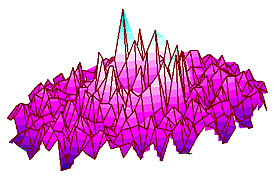| Posted: November 3, 2009 |
Scientists solve timing problem in molecular modeling |
|
(Nanowerk News) A theoretical physicist at the National Institute of Standards and Technology (NIST) has developed a method for calculating the motions and forces of thousands of atoms simultaneously over a wider range of time scales than previously possible. The method overcomes a longstanding timing gap in modeling nanometer-scale materials and many other physical, chemical and biological systems at atomic and molecular levels.
|
 |
| Colorized simulation of what happens to 1100 carbon atoms in a ‘flat’ sheet of graphene about 20 microseconds after the central atom is moved slightly upwards. Darker violet colors indicate atoms that have dropped below their original position, whereas the lighter green colors show where atoms have risen.
|
|
The new mathematical technique* can significantly improve modeling of atomic-scale processes that unfold over time, such as vibrations in a crystal. Conventional molecular dynamics (MD) techniques can accurately model processes that occur in increments measured in picoseconds to femtoseconds (trillionths to quadrillionths of a second). Other techniques can be used over longer periods to model bulk materials but not at the molecular level. The new NIST technique can access these longer time scales—in the critical range from nanoseconds to microseconds (billionths to millionths of a second)—at the molecular level. Scientists can now measure and understand what happens at key points in time that were not previously accessible, and throughout the full spectrum of time scales of interest in MD, says developer Vinod Tewary.
|
|
Modeling of material properties and physical processes is a valuable aid and supplement to theoretical and experimental studies, in part because experiments are very difficult at the nanoscale. MD calculations are usually based on the physics of individual atoms or molecules. This traditional approach is limited not only by time scale, but also by system size. It cannot be extended to processes involving thousands of atoms or more because today’s computers—even supercomputers—cannot handle the billions of time steps required, Tewary says. By contrast, his new method incorporates a “Green’s function,” a mathematical approach that can calculate the condition of a very large system over flexible time scales in a single step. Thus, it overcomes the system size problem as well as the timing gap.
|
|
Tewary illustrated the new technique on two problems. He showed how a pulse propagating through a string of atoms, initiated by moving the middle atom, could be modeled for just a few femtoseconds with conventional MD, whereas the NIST method works for several microseconds. Tewary also calculated how ripples propagate in 1,100 carbon atoms in a sheet of graphene over periods up to about 45 microseconds, a problem that could not be solved previously. Normally thought of as a static flat sheet, the atoms in graphene actually must undulate somehow to remain stable, and the new technique shows how these ripples propagate. (See accompanying image and movie). Consisting entirely of carbon atoms, graphene is a recently discovered honeycomb crystal material that may be an outstanding conductor for wires and other components in nanoscale electronics.
|
|
The new NIST technique is expected to enable modeling of many other processes that occur at time scales of nano- to microseconds, such as formation and growth of defects, conduction of heat, diffusion and radiation damage in materials. The technique could improve results in many different fields, from modeling of new nanotechnologies in the design stage to simulating the radiation damage from a “dirty bomb” over time.
|
|
NIST researchers plan to write a software program encoding the new technique to make it available to other users.
|
|
Reference: V.K. Tewary. Extending time scale in molecular dynamics simulations: propagation of ripples in graphene. Physical Review B, Vol. 80, No. 16.. Published online Oct. 22, 2009.
|

